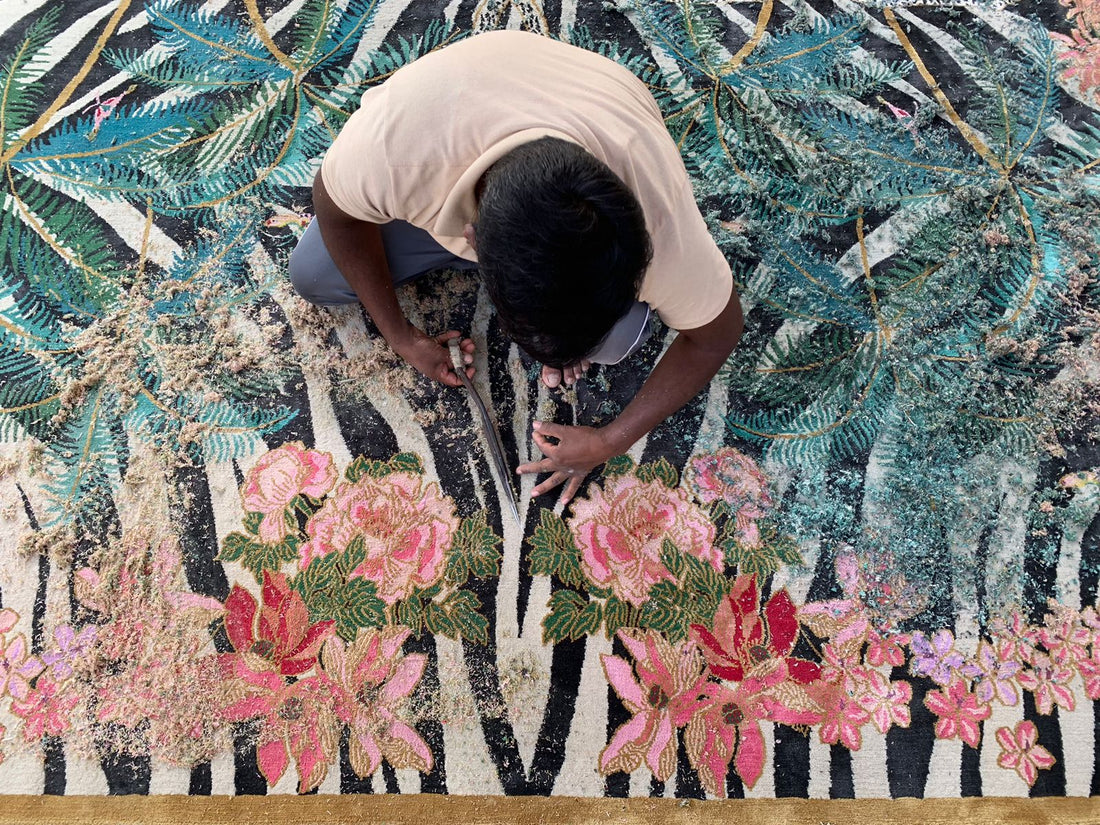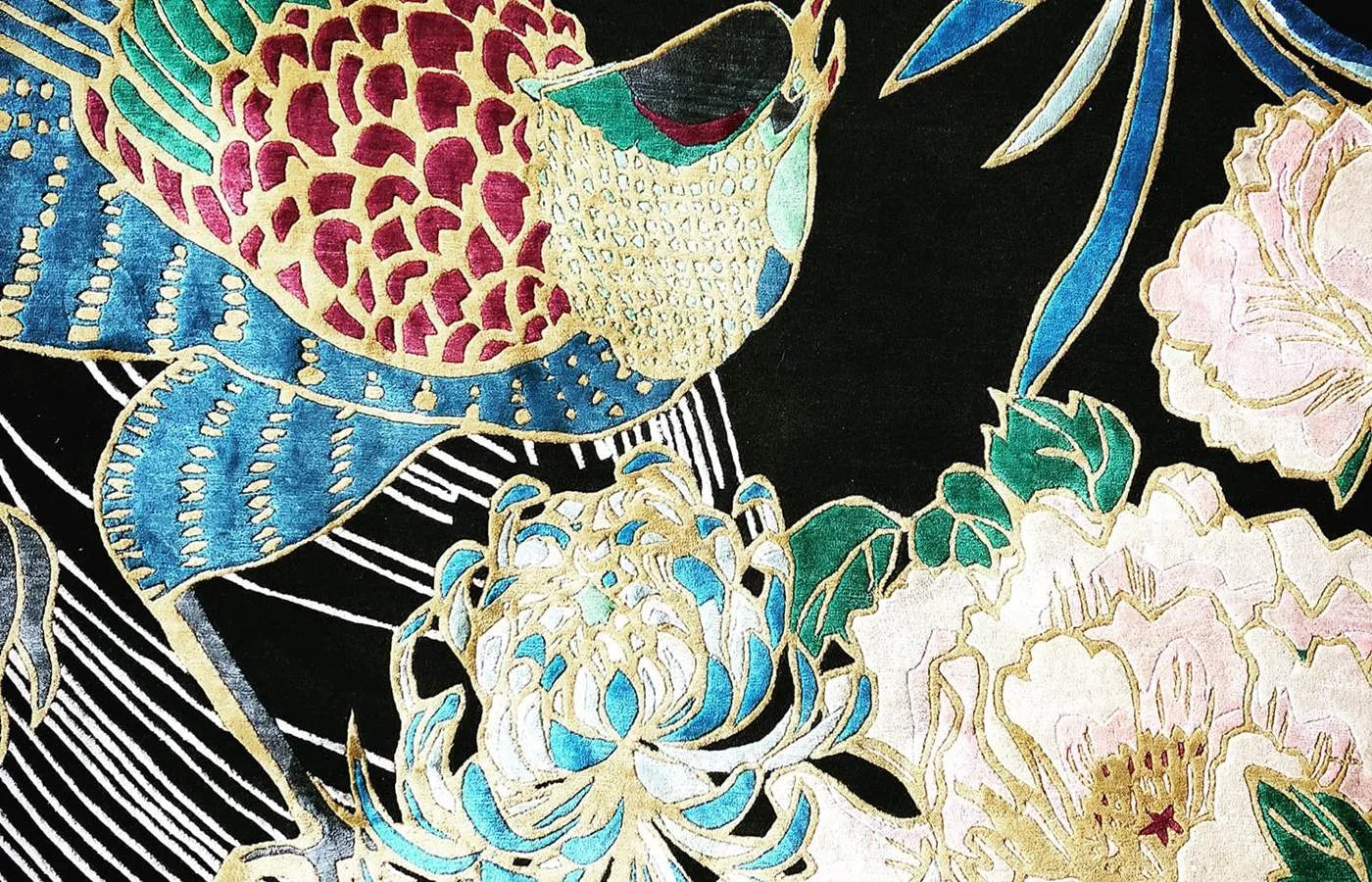
Solace hand-knotted rug displayed in our London Showroom
What do you get when you mix luxurious quality with enthralling craftsmanship? Each one of our hand-knotted rugs is an individually crafted masterpiece, painstakingly handmade by artisans in Nepal. It’s art for your floors that’s crafted with passion.
At Wendy Morrison Design, we celebrate time-honoured skills and every rug showcases dedication to the craft of rug making. Designs are brought to life with intricacy and dexterity, made with expertise passed down the generations. In fact, rug making has been around for thousands of years and continues to be a treasured practice in Nepal.
Hand-knotting is the most labour-intensive process to create a rug. A single hand-knotted rug takes about four to five months to make with up to four weavers working on a rug at a time. From start to finish, quality is the focus to achieve heirloom rugs that are designed to last a lifetime and more.
Label Step Certified
We are proud to be a Certified Label STEP Partner. Ensuring that our rugs are produced ethically and sustainably, considering the welfare of people and our planet. Label STEP is the fair trade, non-profit, organisation committed to the wellbeing of weavers and workers and their families in the handmade carpet industry.

How a hand-knotted rug is made:
Carding and spinning
Dyeing
The Dye Master prepares the dyes to the right colour and the yarn is dyed by hand using traditional pot dyeing methods. Our silk and wool yarns are dyed in small batches so that the process can be controlled to perfection.
Drying
The dyed yarn is allowed to dry naturally in the sun. The sun is very important for the drying process as it gives the yarn a special lustre and nuance to the colour.

Balling
Next, the dyed wool is prepared for weaving. Once the yarns have dried, they’re wound into balls ready for the looms.
Galaincha file
While the yarn is being prepared, pattern designers create a computer-generated graph known as a galaincha file from Wendy’s original design. This acts as a rug map for the weavers, so they know exactly how to recreate the rug pattern and what colour each knot should have.
Weaving on the loom
Hand-knotted rug weaving is carried out on a loom. The loom has a wooden frame strung with vertical threads of cotton looped tightly between the top and bottom bar to create tension. These threads are called warps, then weft threads are woven through horizontally. The warp and weft threads form the structure of each rug.

Every individual knot on a hand-knotted rug is weaved by hand, row after row, using the Tibetan knot technique. This method means the yarn is knotted around the vertical warp threads and a horizontal metal rod, and every new knot is a continuation from the previous one. A time-consuming process that’s renowned for producing the finest quality rugs.
Hand carving
Once weaved, an initial hand carving of the rug details is made using scissors.

Washing
The weaved rug is cleaned several times on both sides to prepare it for finishing. Any dust or dirt that’s become knotted in the yarn is thoroughly washed out using a wooden paddle called ‘pharwa’ that squeezes water through the pile. Washing also helps soften the rugs, creating a luxurious feel. As part of the final washing process, hand-knotted wool rugs are also bathed in Himalayan water.

Our hand-knotted rugs are washed to clean and soften
Stretching
The washed rugs are stretched out to dry and pinned to a frame to ensure they are the correct size. Any wrinkles to the rug are flattened out and the final drying creates deeper and clearer colours.
Shearing and clipping
Binding
The final stage is binding. The edges of the rug are neatly bound by hand using a needle and coordinating yarn that matches the design.
The end result is luxury from every angle. Even the underside of the rug is a thing of beauty where you can see the individual knots and impeccable craftsmanship that has gone into making the designer rug.

Our beautiful design, A Mughal Painting hand-knotted rug almost ready for her forever home!
‘They’re not just rugs – they’re works of art for your floor’
Hand-knotted rugs are antiques of the future and heirlooms that transcend their material value.
Our hand-knotted favourite this month:
Sakura



